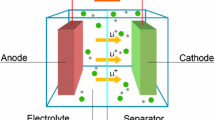Abstract
Increasing the electrode thickness is a significant method to decrease the weight and volume ratio of the inactive components for high energy density of the devices. In this contribution, we extracted a repeating unit in the configurations and establish the empirical energy density model based on some assumptions. In this model, the effects of the electrode thickness on the energy density for lithium-ion batteries (LIBs), lithium metal batteries (LMBs), and anode-free lithium batteries (ALBs) are evaluated quantitively with the current parameters of the batteries. The results demonstrate that the structure evolutions from LIBs, LMBs to ALBs with the reduction of the anode weight contribution, the energy density can be well improved exactly. While the increase of the thickness of the electrode provide another route to further enhance the energy density by decreasing the weight contribution of inactive materials; meanwhile the effects for ALBs are higher than LMBs and LIBs due to the higher weight ratio of inactive materials. This empirical energy density model is also applied into the practical system and provide intuitional results to guide the battery design for higher energy density.





Similar content being viewed by others
References
Manthiram A. A reflection on lithium-ion battery cathode chemistry. Nat Commun. 2020;11:1550.
Zhuo W, Zhang J, Li H. Batteries with high theoretical energy densities. Energy Storage Mater. 2020;26:46.
Bresser D, Hosoi K, Howell D, Li H, Zeisel H, Amine K, Passerini S. Perspectives of automotive battery R&D in China, Germany, Japan, and the USA. J Power Sources. 2018;382:176.
Lu Y, Rong X, Hu Y, Li H, Chen L. Research and development of advanced battery materials in China. Energy Storage Mater. 2019;23:144.
An Y, Liu T, Li C, Zhang X, Hu T, Sun X, Wang K, Wang C, Ma Y. A general route for the mass production of graphene-enhanced carbon composites toward practical pouch lithium-ion capacitors. J Mater Chem A. 2021;9:15654.
Du T, Liu Z, Sun X, Geng L, Zhang X, An Y, Zhang X, Wang K, Ma Y. Segmented bi-material cathodes to boost the lithium-ion battery-capacitors. J Power Sources. 2020;478: 228994.
Zhao C, Guo J, Gu Z, Wang X, Zhao X, Li W, Yu H, Wu X. Flexible quasi-solid-state sodium-ion full battery with ultralong cycle life, high energy density and high-rate capability. Nano Res. 2022;15:925.
Hou B, Wang Y, Ning Q, Li W, Xi X, Yang X, Liang H, Feng X, Wu X. Self-supporting, flexible, additive-free, and scalable hard carbon paper self-interwoven by 1D microbelts: superb room/low-temperature sodium storage and working mechanism. Adv Mater. 2019;31:1903125.
Li W, Li Y, Liu X, Gu Z, Liang H, Zhao X, Guo J, Wu X. All-climate and ultrastable dual-ion batteries with long life achieved via synergistic enhancement of cathode and anode interfaces. Adv Funct Mater. 2022;32:2201038.
Zheng JP, Huang J, Jow TR. The limitations of energy density for electrochemical capacitors. J Electrochem Soc. 1997;144:2026.
Zheng JP. The limitations of energy density of battery/double-layer capacitor asymmetric cells. J Electrochem Soc. 1997;150:A484.
Zheng JP, Andrei P, Jin L, Zheng J, Zhang C. Pre-lithiation strategies and energy density theory of lithium-ion and beyond lithium-ion batteries. J Electrochem Soc. 2022;169: 040532.
Jin L, Zheng J, Zheng JP. Theoretically quantifying the effect of pre-lithiation on energy density of Li-ion batteries. J Electrochem Soc. 2021;168: 010532.
Zhang Y, Li F, Yang K, Liu X, Chen Y, Lao Z, Mai K, Zhang Z. Polymer molecular engineering enables rapid electron/ion transport in ultra-thick electrode for high-energy-density flexible lithium-ion battery. Adv Funct Mater. 2021;31:2100434.
Ue M, Sakaushi K, Uosaki K. Basic knowledge in battery research bridging the gap between academia and industry. Mater Horizons. 2020;7:1937.
Niu C, Liu D, Lochala JA, Anderson CS, Cao X, Gross ME, Xu W, Zhang JG, Whittingham MS, Xiao J, Liu J. Balancing interfacial reactions to achieve long cycle life in high-energy lithium metal batteries. Nat Energy. 2021;6:723.
Acknowledgements
The authors acknowledge the financial support from the National Natural Science Foundation of China, Grant No. 51777140.
Author information
Authors and Affiliations
Corresponding authors
Ethics declarations
Conflict of interest
The authors declare no conflicts of interest.
Additional information
Publisher's Note
Springer Nature remains neutral with regard to jurisdictional claims in published maps and institutional affiliations.
Rights and permissions
About this article
Cite this article
Jin, LM., Xing, GG., Qin, N. et al. An empirical model for high energy density lithium-(ion) batteries with ultra-thick electrodes. Tungsten 6, 230–237 (2024). https://doi.org/10.1007/s42864-022-00163-4
Received:
Revised:
Accepted:
Published:
Issue Date:
DOI: https://doi.org/10.1007/s42864-022-00163-4




